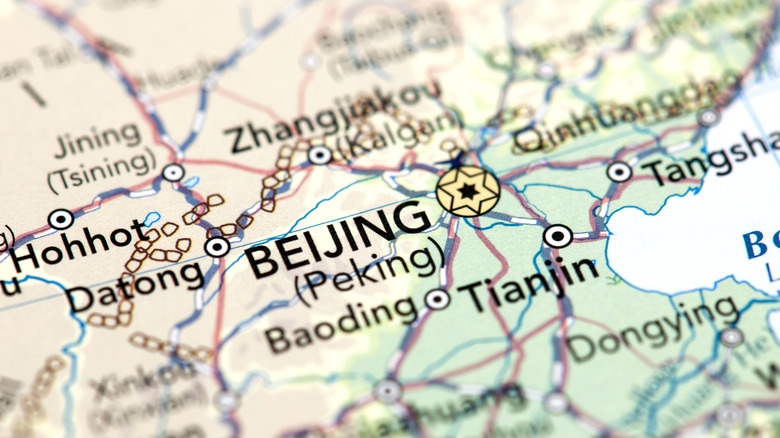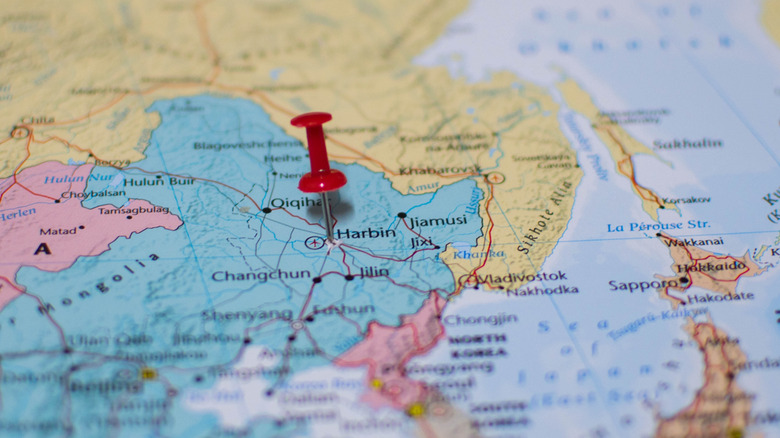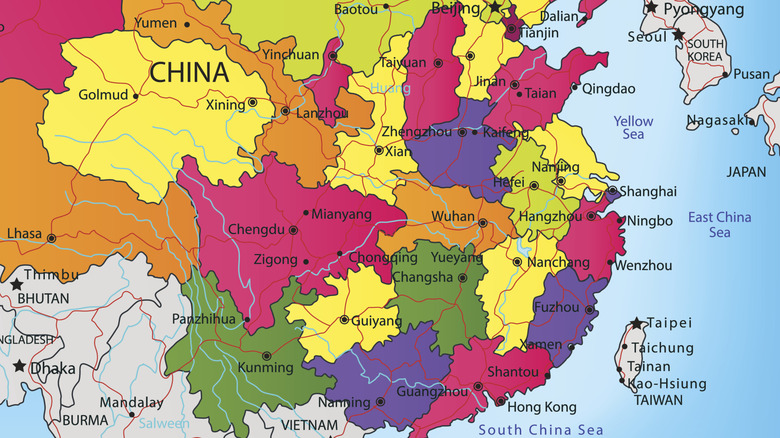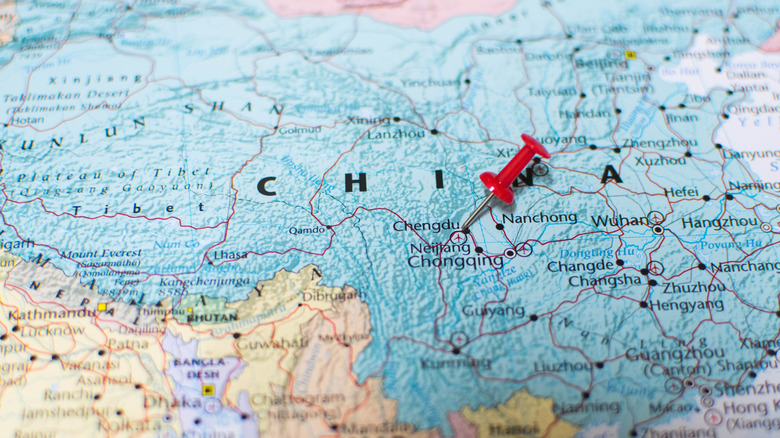The Only Map Of China You Need For Your Upcoming Trip
Spanning nearly 3,250 miles from east to west, and 3,400 miles from north to south (roughly the size of the continental United States), Mainland China is the world's second-largest country in population and fourth largest in land area. Since hearing of Marco Polo's visit in the 13th century along the Silk Road, travelers have yearned to visit the world-renowned historic and cultural sites of this country, including the Great Wall, the terracotta army, and the mythical Forbidden City. For many travelers, China embodies a range of exotic, unique, and at times, strange peculiarities, leaving a yearning to come back and see (or taste) more.
Mainland China borders 14 countries and is administratively split into 32 provinces, cities, and autonomous regions, excluding Hong Kong and Macau, and is further split into seven main regions: the north, the northeast, the east, southeast, central, southwest, and northwest. Each region of China is largely distinct, having thousands of years of local history, and stark differences in food, local cultures, and language. Even though Mandarin, locally called Putonghua, is the lingua franca across Mainland China, many dialects of Chinese are so different that Mandarin speakers may not understand them, though all of them, historically and at present, share a written script — simplified Chinese.
Recently, China has opened its doors to more foreign tourism, where visitors from 55 countries can visit for up to 10 days visa-free if transiting through China to a third country. Don't expect to see it all in one go; visitors are only allowed to travel within specific regions of the country if transiting without a visa. Be sure to understand the conditions of stay before booking your trip. This guide will not include the Special Administrative Zones of Hong Kong and Macau, and will also not include Taiwan. That being said, here is all you need to know about the regions of China before your upcoming trip.
The North
North China stretches across the densely populated North China Plain and includes the provinces of Inner Mongolia, Shanxi, and Hebei, as well as the cities of Beijing and Tianjin. If you're flying in, you'll likely arrive in this region, one of China's cradles of civilization, at the world's largest airport terminal in Beijing — home to Tiananmen Square, the Temple of Heaven, and the Forbidden City. Further afoot outside of China's capital, explore some of the country's past and present cultural and historic marvels. Climb some of the best-preserved sections of the Great Wall, or zip across the Ordos Plateau on China's High Speed Rail (HSR) network to Hohhot and experience traditional Mongolian culture. This region of China has four seasons, and in contrast to other regions down south, it has central heating in the winter. Early spring winds whip up yellow dust storms across Northern China, and it is always a good idea to carry an N95 mask when going out.
Cuisine in this part of China is hearty and filling; quintessential can't miss meals include Peking Duck (which originated near Shanghai), zhajiangmian (hand-pulled noodles), and classic Chinese breakfast dishes, including baozi (stuffed meat buns), jiaozi (small meat dumplings), and local varieties of youtiao, a long strip of fried dough served with soy milk. Locals primarily speak the dialect of Mandarin that is used nationally, though language has been a thorny issue in the past, as are these 'three T's' that everyone should avoid talking about when in China.
The Northeast
China's northeast is locally called Dongbei and includes the provinces of Heilongjiang, Jilin, and Liaoning. This is the country's first industrial heartland and the birthplace of China's last Manchu emperor during the Qing Dynasty. From 1931 until the end of World War II, this resource-rich part of China was called Manchukuo and run under the control of the Japanese military, and later became the focal point of many of China's state-run enterprises until economic reforms in the 1980s under Deng Xiaoping. Peel back Dongbei's rough post-industrial exterior and you'll find hidden gems, including the Panjin Red Beach in Liaoning Province and the world's largest ice and snow festival in Russian-influenced Harbin, the capital of Heilongjiang Province. Bundle up as "the Ice City" lives up to its name in winter. It gets down to -11 Fahrenheit (-24 Celsius) in January.
The cuisine in this part of China is hearty and filling; noodles and soups are thicker, as are the steamed buns. Rather than the rice-based diets of the south, locals in the Northeast rely heavily on familiar crops grown in the West, including wheat, potatoes, corn, as well as pickled vegetables, and local-style sweet and sour pork. One interesting thing about this region is that it borders North Korea, and contains one of the few places where travelers can stand on a tri-national border between China, Russia, and North Korea. Intrepid travelers can cross over to Raison in North Korea from here, provided you're not a citizen of the U.S. or South Korea.
The East
China's east largely stretches from Shandong Province south to Fujian, encompassing Shanghai and its instantly recognizable Pudong skyline. The city of Qingdao, formerly called Tsingtao, in Shandong Province, is widely known for its seafood and is home to China's well-known Tsingtao brewery, built by the Germans who colonized the city. Qingdao also hosts "China's Oktoberfest," the Qingdao International Beer Festival each summer.
While Beijing is largely historic and traditional, Shanghai is pulsing and cosmopolitan and was known as the "Paris of the East". Start your day bright and early with a morning stroll around the city's beautiful Bund and historic French Concession, and soak in the historic and modern vibes. Past the neon and the glitz, this area holds hidden important historical moments in plain view, including the place where China's Communist Party gathered for the first time. If you're longing for an architectural taste of Europe, you'll also find two of China's unique replica cities in this part of the country, a few hours from Shanghai.
If you need a break from the hustle, head further south along the coast to overlooked Fujian province, full of charming villages and outdoor adventures in Wuyishan National Park. Xiamen, formerly Amoy, is a historic and cosmopolitan port that morphed into one of China's first Special Economic Zones (SEZ), where foreign investment was encouraged. Many overseas Chinese in Southeast Asia trace their roots to this part of the country, and the local cuisine is similar to the Chinese food you'd find in other nearby nations like Malaysia and Singapore. This part of the country is subtropical and the weather is hot and humid, especially in the summer months.
Central China
If you're looking for some of China's best scenery or to dive deep into the heart of Chinese culture, Central China's three provinces of Henan, Hubei, and Hunan beckon. Songshan Mountain in Central China's Henan Province is the birthplace of Shaolin Kung Fu, drawing foreign practitioners to the region. Though many of the original relics were destroyed during the Cultural Revolution, from 1966 until soon after Mao Zedong's death, later the Chinese government rebuilt the temple and re-established the schools. However, today, the temple may not entirely follow true Shaolin practices.
Hunan Province is home to Zhangjiajie, the inspiration for the scenery of the movie "Avatar." Though the natural scenery is truly breathtaking, the national park and its famous glass bridge have taken social media by storm — so, expect massive crowds and long lines. Another major draw, in particular for domestic tourists, is Shaoshan, Mao Zedong's birthplace. Here, you'll find statues and t-shirts of Chairman Mao for sale on the streets.
Hubei Province sits at the center of it all. Flowing through Hubei, the mighty Yangtze River has given life to modern and ancient Chinese civilization. The province's capital, Wuhan, was formed in 1949 from three separate cities where the mighty Yangtze and Han Rivers meet. Upriver, you'll find the world's largest hydroelectric dam, the Three Gorges Dam, and Yichang, the starting point for many gorgeous river cruises to Chongqing through the Yangtze's breathtaking gorges and bends.
The Southeast
Southeast China is a buzzing place and includes the island province of Hainan as well as Guangxi and Guangdong. Guangdong Province has over 127 million people living in 76,100 square miles (roughly the size of Nebraska). Formerly known as the "world's factory," Guangdong has transformed into a burgeoning tech and logistics hub, encompassing and integrating China's two Special Administrative Regions, Hong Kong and Macau. Two of Guangdong's major cities, Guangzhou, formerly known as Canton, and booming Shenzhen, China's first SEZ located across the border from Hong Kong, have largely driven much of the region's development and made the province the wealthiest in China. Further south, you'll find "China's Hawaii," Hainan Island, complete with sandy beaches and luxury resorts.
The autonomous region of Guangxi, west of Guangdong, is known for diversity in nature as well as in local cultures. Back roads and incredibly scenic views lead to minority villages across the autonomous region. Guangxi has the highest total of ethnic minorities in the country, and it's a place where you can go off the beaten path and explore traditional markets with few other Westerners. Guangxi is notably less developed than its eastern neighbor and doesn't have the glitz, but it is full of charm. Outside of Nanning, the capital of Guangxi, you're spoilt for choice in terms of what to explore, from villages to forested karst mountains, or even other countries. The city is a hub for flights to Southeast Asia and is connected to neighboring Vietnam by rail. Before you go, don't miss witnessing some of China's best natural secrets around Guilin and Yangshuo.
The Southwest
Southwestern China includes some of the country's most sought-after destinations and the provinces of Tibet, Sichuan, Yunnan, and Guizhou, as well as the megacity of Chongqing. Who doesn't love those cute, cuddly pandas, or a night out gorging on hot pot? You'll likely arrive in Sichuan's bustling and historic capital, Chengdu, which is served with direct flights from the West Coast of North America, Europe, and Australia. Hot pot may come from Sichuan; however, it's only fitting that the world's largest city by population, Chongqing, is home to the world's largest hotpot restaurant. Hop on the High Speed Rail, and you'll be there in a little over an hour. West of Chengdu, you'll find the Dujiangyan Irrigation System, one of China's ancient engineering marvels that has been designated a UNESCO World Heritage Site. It may have been built sometime around 256 B.C., but it is still used today.
Ethnically diverse Yunnan Province borders Myanmar, Laos, and Vietnam, and flies under the radar for many travelers. However, visitors looking to explore China's cultural roots and former kingdoms shouldn't miss visiting the ancient cities of Lijiang, Dali, and the mythical Shangri-la. Yunnan is at a subtropical latitude, though many of the province's top cities and tourist attractions are high up (over 4,500 feet) above sea level. If you're planning to hike or tackle Tiger Leaping Gorge, take a few days to acclimate in Kunming, the province's capital, and explore the nearby Stone Forest. Further west, the magic and mysticism of Tibet looms. If you're planning to visit Tibet, don't forget that you'll need a Tibet Travel Permit which needs to be obtained through a Chinese travel agency, along with your Chinese visa.
The Northwest
Fewer Westerners make it out to northwestern China, one of the country's most exotic and historic regions that includes the provinces of Shaanxi, Ningxia, Gansu, Qinghai, and Xinjiang. This is where you'll likely note clear differences in food, cultures, and languages. The core of the region, Xi'an, is the oldest of China's four great ancient capitals, and the eastern end point of the Silk Road. This ancient city is surrounded by a well-preserved, walkable ancient wall. Xi'an is also 30 minutes from the incredible tomb of Emperor Qin Shi Huang, protected by a terracotta army for over two millennia. If you're not able to make it out further west, the city's Muslim quarter is a popular place to try lamb kebabs.
Far out in Xinjiang, nearly 2,500 miles from Beijing — though officially in the same time zone — you'll find one of the oldest cities in the world, Kashgar, an ancient traveler's oasis along the Silk Road. If you'd like to see the beautiful and jaw-dropping desert landscapes from the ground, rather than from 30,000 feet up, take the High Speed Rail to the region's capital, largest city, and main transportation hub, Urumqi. If Kashgar is too far out (the cities are over 900 miles apart), take a day or two to explore the ancient Silk Road city of Turpan. While in Xinjiang, don't miss trying Dapanji, a spicy chicken noodle Chinese fusion dish that uses ingredients found in Uyghur and Sichuan kitchens. Security is tight in this area of China, and you can expect to walk through metal detectors, see plenty of armed police, and be surrounded by surveillance cameras at almost all times in public.
Though you will not need an additional permit to enter this region, apart from international border areas, only Xi'an airport is an approved transit point for the 10-day visa-free stopover (and you can't leave Shaanxi Province). If you'd like to visit Xinjiang, you will need to apply for a visa from your closest Chinese embassy or consulate if your country is not visa exempt. This means that travelers from countries, including the U.S., Canada, and the U.K., will need a tourist visa to visit most of Northwest China.







